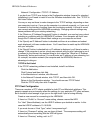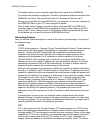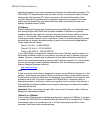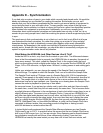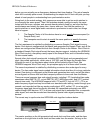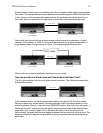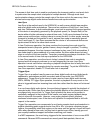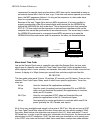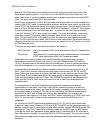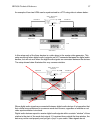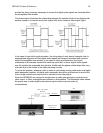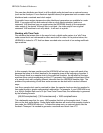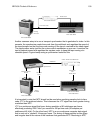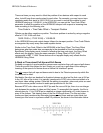HD24/96 Technical Reference 95
Basically, 29.97 fps time code is exactly the same as 30 fps time code except that it has
been slowed down by about .1% so that it runs at the NTSC color video frame rate. The
good news is that if you don’t produce anything that is going to synchronize to color NTSC
video, you don’t need to use 29.97 fps time code.
Even though the invention of 29.97 fps time code solved the problem of synchronizing time
code to color NTSC video, it created another problem: while the frame rate of the time code
runs at 29.97 fps, it counts as though it is actually running faster. The net result is that at the
end of an hour, the time code display reads 00:59:56:12 instead of 1:00:00:00. The problem
is exactly analogous to why we have leap year – to correct for the fact that our calendar
“runs fast” by about 0.07% (one day per four years). To correct this problem, drop frame
code was invented. Drop frame code periodically “skips ahead” a bit to make up for lost
time. The end result is that at the end of an hour, the slow clock has skipped ahead by
00:00:03:18 so that the clock reads 1:00:00 after an hour has passed. Drop frame works by
skipping ahead (in count) by two frames every minute, except for the 10
th
minute, for a total
of 108 frames per hour.
There are two drop frame codes which are used in the industry:
29.97 fps Drop Used for broadcast NTSC video applications in the US, Canada and
Japan.
30 fps Drop Used primarily for correcting time code related problems in broadcast
NTSC video applications in the US, Canada and Japan.
Drop frame time code is typically only used in broadcast applications where program
scheduling is ruled by wall clock time (after all, you can’t broadcast the 12:00 news at
12:30). The great news is that unless you are a broadcaster or have to deliver something
that will be broadcast on air, you don’t need to worry about drop frame time code either.
In practice there are actually four different speeds (rates) at which time code runs (24, 25,
29.97, and 30 fps), and four different ways that frames are counted (24, 25, 30, and 30
Drop). When you shake them all together and spill them on the table you get the six Time
Code Frame Rates we described above. Whereas almost all equipment supports 29.97
Drop, not all equipment supports 30 Drop. The HDR24/96 supports all six standard fame
rates, but don’t use 30 Drop unless you need to do so in order to be compatible with
something else.
An important fact to know is that different manufacturers sometimes use different
nomenclature for the same Time Code Frame Rates, primarily because of a failure to
differentiate between the frame rate (how fast the code is running) and the frame count
(how many frames in a second). This can be very confusing. The discrepancies always
surround how 29.97 and 30 Drop and non-drop are represented. For example, one
manufacturer may support 30, 30 drop, and 29.97 (which in actuality is 30, 29.97 drop, and
29.97). If you see only 5 of the six rates supported, you can bet that 30 Drop is not
supported.
As a final note, the MTC specification defines only 24, 25, 30, and 30 Drop frame rates
(based on frame count). However, 29.97 and 29.97 Drop MTC can be generated simply by
slowing down the rate of transmission slightly. Many devices, like the HDR24/96 do this. But
because the Time Code Frame Rate is actually coded into the MTC data, an MTC reader
(as might be found on a sequencer) might display that it is receiving 30 or 30 Drop frame
time code when in actuality it is receiving 29.97 or 29.97 Drop frame. The only way to know
what is actually happening is to know how your equipment specifically deals with these
situations.



